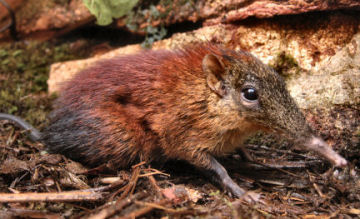New elephant-shrew
Researchers have discovered a species of elephant-shrew that is entirely new to science.
By Emily Sohn
The world is full of quirky creatures, and the elephant-shrew is a perfect example. These furry, long-nosed animals resemble a mix between miniature antelopes, anteaters, and rodents, says Galen Rathbun of the California Academy of Sciences in San Francisco. Even though their name and appearance suggest otherwise, elephant-shrews are more closely related to aardvarks, sea cows, and elephants than they are to shrews.
Now, scientists have found the largest species of elephant-shrew yet. At about 1.5 pounds (700 grams), the newly discovered animal is slightly bigger than a gray squirrel. The find is especially exciting because more than a century has passed since scientists last discovered a completely new species of elephant-shrew.
 |
|
It looks like a rodent but is related to an elephant. This is the first new species of elephant-shrew discovered in more than a century.
|
| F. Rovero/Trento (Italy) Museum of Natural Sciences |
With the discovery, the count of elephant-shrew species now stands at sixteen. Called Rhynchocyon udzungwensis, the newly found creature joins a group of three other giant elephant-shrews, all of which are bigger and more varied in color than their mousier cousins. R. udzungwensis has a grey face, a black rump, and a brown back.
In 2005, Italian researchers first captured pictures of the new animal by mistake. Francesco Rovero of the Trento Museum of Natural Sciences and his colleagues were working in Tanzania’s Udzungwa Mountains, and they set up a camera to survey small forest antelopes. Instead, the unmanned camera snapped images of a giant elephant-shrew that looked like a new species.
One year later, Rovero, Rathbun, and other scientists set off on an expedition to search for the mysterious creature. After hiking through the African jungle for half an hour, they were surprised to find an elephant-shrew lying on the path. Indeed, it was the new species they were looking for.
With traditional African snares, the researchers were able to trap four of the animals. The scientists also found leaf piles that the giant elephant-shrews nestle in to sleep.
So far, scientists know of only two populations of the new creature. Both groups live within an area measuring just 300 square kilometers (115 square miles). A variety of other rare creatures, including unusual kinds of shrews, monkeys, amphibians, and reptiles, lives in the same region. The researchers hope their new discovery will help boost protection of Tanzania’s unique forests.







